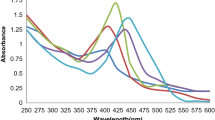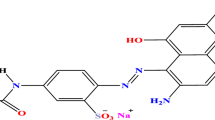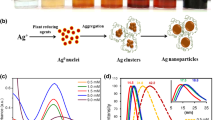Abstract
Green synthesized nanoparticles from Strobilanthes barbatus leaf extracts are environmentally safe and feasible for enduring wastewater treatment, especially for organic textile dye degradation. The synthesized Strobilanthes barbatus–mediated silver/silver-oxide nanoparticles (SB-Ag/AgO NPs) showed maximum absorbance at 428 nm. The SB-Ag/AgO NPs were generally spherical with an average diameter of 37.59 nm (FESEM and TEM analysis). The importance of functional groups in the production of SB-Ag/AgO NPs was recorded by FTIR investigations. In the degradation and rate of degradation for textile dyes, after 320 min, SB-Ag/AgO NPs displayed 96.60% (5.31 × 10−1 L mg−1 min−1) and 87.50% (1.179 × 10−1 L mg−1 min−1) degradation of Reactive Blue 220 (RB-220) and Reactive Blue 222A (RB-222A), respectively. When compared to dye effluents, SB-Ag/AgO NPs-treated dye solutions revealed a considerable decrease in inhibitory efficiency during phytotoxicity evaluation on test organisms, Vigna radiata and Artemia salina. The biosynthesized SB-Ag/AgO NPs could serve as a feasible photocatalyst for the treatment of organic textile dyes in organic substance–polluted water ecosystems. SB-Ag/AgO NPs can serve as efficient, cost-effective and environmentally friendly sources for dye degradation. The current research offers a safe and environmentally friendly strategy for sustaining the environment.










Similar content being viewed by others
Data availability
All relevant data are included in the paper.
References
Al-Tohamy R, Ali SS, Li F et al (2022) A critical review on the treatment of dye-containing wastewater: ecotoxicological and health concerns of textile dyes and possible remediation approaches for environmental safety. Ecotoxicol Environ Saf 231:113160. https://doi.org/10.1016/j.ecoenv.2021.113160
Gangwar J, Kadanthottu Sebastian J, Puthukulangara Jaison J, Kurian JT (2023) Nano-technological interventions in crop production—a review. Physiol Mol Biol Plants 29:93–107. https://doi.org/10.1007/s12298-022-01274-5
Lellis B, Fávaro-Polonio CZ, Pamphile JA, Polonio JC (2019) Effects of textile dyes on health and the environment and bioremediation potential of living organisms. Biotechnol Res Innov 3:275–290. https://doi.org/10.1016/j.biori.2019.09.001
Ardila-Leal LD, Poutou-Piñales RA, Pedroza-Rodríguez AM, Quevedo-Hidalgo BE (2021) A brief history of colour, the environmental impact of synthetic dyes and removal by using laccases. Molecules 26:3813. https://doi.org/10.3390/molecules26133813
Mahmood A, Ali S, Saleem H, Hussain T (2011) Optimization for degradation of commercial Reactive Yellow dye 145 through Fenton’s reagent. Asian J Chem 5
Dikshit P, Kumar J, Das A et al (2021) Green synthesis of metallic nanoparticles: applications and limitations. Catalysts 11:902. https://doi.org/10.3390/catal11080902
Gangwar J, Sebastian JK, Chandran P (2023) Advanced bionanomaterials for environmental remediation. In: Academic A (ed) Sustainable nanomaterials for biosystems engineering, 1st edn. Press, New York, pp 193–211
Nandhini NT, Rajeshkumar S, Mythili S (2019) The possible mechanism of eco-friendly synthesized nanoparticles on hazardous dyes degradation. Biocatal Agric Biotechnol 19:101138. https://doi.org/10.1016/j.bcab.2019.101138
Alprol AE, Mansour AT, El-Beltagi HS, Ashour M (2023) Algal extracts for green synthesis of zinc oxide nanoparticles: promising approach for algae bioremediation. Materials 16:2819. https://doi.org/10.3390/ma16072819
Puthukulangara Jaison J, Kadanthottu Sebastian J (2023) Photocatalytic and antioxidant potential of silver nanoparticles biosynthesized using Artemisia stelleriana leaf extracts. Water Pract Technol 18:2664–2674. https://doi.org/10.2166/wpt.2023.176
Alprol AE, Mansour AT, Abdelwahab AM, Ashour M (2023) Advances in green synthesis of metal oxide nanoparticles by marine algae for wastewater treatment by adsorption and photocatalysis techniques. Catalysts 13:888. https://doi.org/10.3390/catal13050888
Mansour AT, Alprol AE, Abualnaja KM et al (2022) The using of nanoparticles of microalgae in remediation of toxic dye from industrial wastewater: kinetic and isotherm studies. Materials 15:3922. https://doi.org/10.3390/ma15113922
Mansour AT, Alprol AE, Khedawy M et al (2022) Green synthesis of zinc oxide nanoparticles using red seaweed for the elimination of organic toxic dye from an aqueous solution. Materials 15:5169. https://doi.org/10.3390/ma15155169
Alprol AE, Heneash AMM, Ashour M et al (2021) Potential applications of Arthrospira platensis lipid-free biomass in bioremediation of organic dye from industrial textile effluents and its influence on marine rotifer (Brachionus plicatilis). Materials 14:4446. https://doi.org/10.3390/ma14164446
Samuel MS, Ravikumar M, John JA et al (2022) A review on green synthesis of nanoparticles and their diverse biomedical and environmental applications. Catalysts 12:459. https://doi.org/10.3390/catal12050459
Ahmed SF, Mofijur M, Rafa N et al (2022) Green approaches in synthesising nanomaterials for environmental nanobioremediation: technological advancements, applications, benefits and challenges. Environ Res 204:111967. https://doi.org/10.1016/j.envres.2021.111967
Wood JRI, Scotland RW (2009) New and little-known species of Strobilanthes (Acanthaceae) from India and South East Asia. Kew Bull 64:3–47. https://doi.org/10.1007/s12225-009-9098-2
Bennett JR, Scotland RW (2003) A revision of Strobilanthes (Acanthaceae) in Java. Kew Bull 58:1. https://doi.org/10.2307/4119356
Subbulakshmi K, Godwin S, Vahab A (2015) Phytochemical and in-vitro antioxidant activity of ethanolic extract of Strobilanthes barbatus Nees leaves. AJPRD 3:13–20
Wangkheirakpam SD, Devi WR, Singh CB, Laitonjam WS 2016 Green synthesis of silver nanoparticles using Strobilanthes flaccidifolius Nees Leaf Extract and its Antibacterial Activity JAC 8 1523 1532 https://doi.org/10.24297/jac.v8i1.4033
Meena S, Vaya D, Das BK (2016) Photocatalytic degradation of malachite green dye by modified ZnO nanomaterial. Bull Mater Sci 39:1735–1743. https://doi.org/10.1007/s12034-016-1318-4
Golmohammadi M, Nabipoor Hassankiadeh M, AlHammadi A, Elkamel A (2023) Fabrication of green synthesized SnO2–ZnO/bentonite nanocomposite for photocatalytic degradation of organic dyes. J Clust Sci 34:2275–2286. https://doi.org/10.1007/s10876-022-02379-3
Dharshini RS, Poonkothai M, Srinivasan P et al (2021) Nano-decolorization of methylene blue by Phyllanthus reticulatus iron nanoparticles: an eco-friendly synthesis and its antimicrobial, phytotoxicity study. Appl Nanosci. https://doi.org/10.1007/s13204-021-02002-3
Bilal M, Iqbal M, Hu H, Zhang X (2016) Mutagenicity, cytotoxicity and phytotoxicity evaluation of biodegraded textile effluent by fungal ligninolytic enzymes. Water Sci Technol 73:2332–2344. https://doi.org/10.2166/wst.2016.082
Kumar B, Smita K, Cumbal L, Debut A (2017) Green synthesis of silver nanoparticles using Andean blackberry fruit extract. Saudi J Biol Sci 24:45–50. https://doi.org/10.1016/j.sjbs.2015.09.006
Melkamu WW, Bitew LT (2021) Green synthesis of silver nanoparticles using Hagenia abyssinica (Bruce) J.F. Gmel plant leaf extract and their antibacterial and anti-oxidant activities. Heliyon 7:e08459. https://doi.org/10.1016/j.heliyon.2021.e08459
Mukaratirwa-Muchanyereyi N, Gusha C, Mujuru M et al (2022) Synthesis of silver nanoparticles using plant extracts from Erythrina abyssinica aerial parts and assessment of their anti-bacterial and anti-oxidant activities. Results Chem 4:100402. https://doi.org/10.1016/j.rechem.2022.100402
Iravani S, Korbekandi H, Mirmohammadi SV, Zolfaghari B (2014) Synthesis of silver nanoparticles: chemical, physical and biological methods. Res Pharm Sci 9:385–406
Abdalameer NKh, Khalaph KA, Ali EM (2021) Ag/AgO nanoparticles: green synthesis and investigation of their bacterial inhibition effects. Mater Today Proc 45:5788–5792. https://doi.org/10.1016/j.matpr.2021.03.166
Giri AK, Jena B, Biswal B et al (2022) Green synthesis and characterization of silver nanoparticles using Eugenia roxburghii DC extract and activity against biofilm-producing bacteria. Sci Rep 12:8383. https://doi.org/10.1038/s41598-022-12484-y
Yulizar Y, Apriandanu DOB, Ashna RI (2020) La2CuO4-decorated ZnO nanoparticles with improved photocatalytic activity for malachite green degradation. Chem Phys Lett 755:137749. https://doi.org/10.1016/j.cplett.2020.137749
El Messaoudi N, El Mouden A, Fernine Y et al (2022) Green synthesis of Ag2O nanoparticles using Punica granatum leaf extract for sulfamethoxazole antibiotic adsorption: characterization, experimental study, modeling, and DFT calculation. Environ Sci Pollut Res 30:81352–81369. https://doi.org/10.1007/s11356-022-21554-7
Ali IAM, Ahmed AB, Al-Ahmed HI (2023) Green synthesis and characterization of silver nanoparticles for reducing the damage to sperm parameters in diabetic compared to metformin. Sci Rep 13:2256. https://doi.org/10.1038/s41598-023-29412-3
Skiba MI, Vorobyova VI, Pivovarov A, Makarshenko NP (2020) Green synthesis of silver nanoparticles in the presence of polysaccharide: optimization and characterization. J Nanomater 2020:1–10. https://doi.org/10.1155/2020/3051308
Hemmati S, Rashtiani A, Zangeneh MM et al (2019) Green synthesis and characterization of silver nanoparticles using Fritillaria flower extract and their antibacterial activity against some human pathogens. Polyhedron 158:8–14. https://doi.org/10.1016/j.poly.2018.10.049
Qing W, Chen K, Wang Y et al (2017) Green synthesis of silver nanoparticles by waste tea extract and degradation of organic dye in the absence and presence of H2O2. Appl Surf Sci 423:1019–1024. https://doi.org/10.1016/j.apsusc.2017.07.007
Laouini SE, Bouafia A, Soldatov AV et al (2021) Green synthesized of Ag/Ag2O nanoparticles using aqueous leaves extracts of Phoenix dactylifera L. and their azo dye photodegradation. Membranes 11:468. https://doi.org/10.3390/membranes11070468
Edison TNJI, Lee YR, Sethuraman MG (2016) Green synthesis of silver nanoparticles using Terminalia cuneata and its catalytic action in reduction of direct yellow-12 dye. Spectrochim Acta A Mol Biomol 161:122–129. https://doi.org/10.1016/j.saa.2016.02.044
Shaikh WA, Chakraborty S, Islam RU (2020) Photocatalytic degradation of rhodamine B under UV irradiation using Shorea robusta leaf extract-mediated bio-synthesized silver nanoparticles. Int J Environ Sci Technol 17:2059–2072. https://doi.org/10.1007/s13762-019-02473-6
Palani G, Trilaksana H, Sujatha RM et al (2023) Silver nanoparticles for waste water management. Molecules 28:3520. https://doi.org/10.3390/molecules28083520
Jouyandeh M, Mousavi Khadem SS, Habibzadeh S et al (2021) Quantum dots for photocatalysis: synthesis and environmental applications. Green Chem 23:4931–4954. https://doi.org/10.1039/D1GC00639H
Saeed M, Muneer M, Haq AU, Akram N (2022) Photocatalysis: an effective tool for photodegradation of dyes—a review. Environ Sci Pollut Res 29:293–311. https://doi.org/10.1007/s11356-021-16389-7
Kumari H, Sonia S et al (2023) A review on photocatalysis used for wastewater treatment: dye degradation. Water Air Soil Pollut 234:349. https://doi.org/10.1007/s11270-023-06359-9
Rab Nawaz HZ, Falak U, Naz T et al (2022) Synthesis of silver/silver oxide heterostructures via partial reduction of AgNO3 using a novel green reducing agent. Ceram Int 48:37194–37202. https://doi.org/10.1016/j.ceramint.2022.08.296
Modi S, Yadav VK, Choudhary N et al (2022) Onion peel waste mediated-green synthesis of zinc oxide nanoparticles and their phytotoxicity on mung bean and wheat plant growth. Materials 15:2393. https://doi.org/10.3390/ma15072393
Ozkan Y, Altinok I, Ilhan H, Sokmen M (2016) Determination of TiO2 and AgTiO2 nanoparticles in Artemia salina: toxicity, morphological changes, uptake and depuration. Bull Environ Contam Toxicol 96:36–42. https://doi.org/10.1007/s00128-015-1634-1
Ravichandran V, Sumitha S, Ning CY et al (2020) Durian waste mediated green synthesis of zinc oxide nanoparticles and evaluation of their antibacterial, antioxidant, cytotoxicity and photocatalytic activity. Green Chem Lett Rev 13:102–116. https://doi.org/10.1080/17518253.2020.1738562
Verma AK, Raghukumar C, Parvatkar RR, Naik CG (2012) A rapid two-step bioremediation of the anthraquinone dye, Reactive Blue 4 by a marine-derived fungus. Water Air Soil Pollut 223:3499–3509. https://doi.org/10.1007/s11270-012-1127-3
Funding
No funding was received to conduct this study.
Author information
Authors and Affiliations
Contributions
All authors contributed to the study conception and design. Material preparation, data collection and analysis were performed by Jaya Gangwar and Joseph Kadanthottu Sebastian. The first draft of the manuscript was written by Jaya Gangwar, and all authors commented on previous versions of the manuscript. All authors read and approved the final manuscript.
Corresponding author
Ethics declarations
Ethical approval
Not applicable.
Competing interests
The authors declare no competing interests.
Additional information
Publisher's Note
Springer Nature remains neutral with regard to jurisdictional claims in published maps and institutional affiliations.
Rights and permissions
Springer Nature or its licensor (e.g. a society or other partner) holds exclusive rights to this article under a publishing agreement with the author(s) or other rightsholder(s); author self-archiving of the accepted manuscript version of this article is solely governed by the terms of such publishing agreement and applicable law.
About this article
Cite this article
Gangwar, J., Joseph, K.S. Eco-conscious photocatalytic degradation of organic textile dyes using green synthesized silver nanoparticles: a safe and green approach toward sustainability. Biomass Conv. Bioref. (2024). https://doi.org/10.1007/s13399-024-05348-0
Received:
Revised:
Accepted:
Published:
DOI: https://doi.org/10.1007/s13399-024-05348-0




